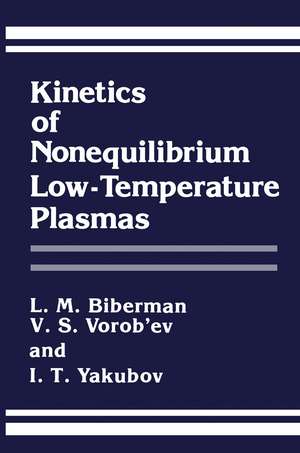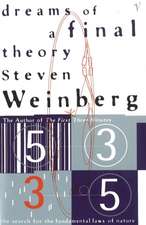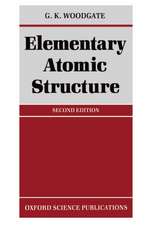Kinetics of Nonequilibrium Low-Temperature Plasmas
Autor L.M. Biberman, V.S. Vorob'ev, I.T. Yakuboven Limba Engleză Paperback – 18 mar 2012
Preț: 649.22 lei
Preț vechi: 763.78 lei
-15% Nou
Puncte Express: 974
Preț estimativ în valută:
124.27€ • 135.03$ • 104.45£
124.27€ • 135.03$ • 104.45£
Carte tipărită la comandă
Livrare economică 21 aprilie-05 mai
Preluare comenzi: 021 569.72.76
Specificații
ISBN-13: 9781468416671
ISBN-10: 1468416677
Pagini: 500
Ilustrații: 498 p.
Dimensiuni: 152 x 229 x 26 mm
Greutate: 0.66 kg
Ediția:Softcover reprint of the original 1st ed. 1987
Editura: Springer Us
Colecția Springer
Locul publicării:New York, NY, United States
ISBN-10: 1468416677
Pagini: 500
Ilustrații: 498 p.
Dimensiuni: 152 x 229 x 26 mm
Greutate: 0.66 kg
Ediția:Softcover reprint of the original 1st ed. 1987
Editura: Springer Us
Colecția Springer
Locul publicării:New York, NY, United States
Public țintă
ResearchDescriere
The first research on plasma was done in connection with the study of electrical discharges in gases. The focus of attention for physicists was the partially ionized plasma, the kinetics of which is governed by various collisional and radiative processes. The choice of this area of research was motivated largely by the practical problems of that time the creation of gas-discharge light sources, rectifiers, and inverters. Since the early 1950s interest in plasma physics has risen sharply, particularly in the study of the completely ionized plasma with its various collective phenomena, insta bilities, and the interesting and sometimes unexpected effects attending the propagation of electromagnetic waves in such a plasma and the action on it of external electric and magnetic fields. Interest in hot plasmas has been stimulated not only by the diverse and novel physical phenomena, but also by the problems arising in connection with controlled nuclear fusion. The advent, in the early 1960s, of new technical fields such as gas-discharge lasers, magnetohydrodynamic generators, thermoemission converters, plasma chemistry, plasma propul sion devices, various methods in plasma technology, etc. , has led to increased interest in weakly ionized low-tempera ture plasmas. This is particularly true of nonequilibrium plasmas, which are characterized by an extraordinary diver sity of states and properties.
Cuprins
One Low-Temperature Plasma. General Information.- 1.1. Quasineutrality. Debye Screening.- 1.2. Ideal Plasma.- 1.3. Equilibrium Plasma.- 1.4. Local Thermodynamic Equilibrium. Elementary Processes.- 1.5. Features of the Transport Phenomena.- 1.6. Nonequilibrium Low-Temperature and High-Temperature Plasmas.- Two Elementary Processes in a Low-Temperature Plasma.- 2.1. Elastic Collisions.- 2.1.1. Coulomb Collisions.- 2.1.2. Elastic Scattering of Electrons by Atoms and Molecules.- 2.2. Inelastic Collisions of Electrons with Atoms, Ions, and Molecules.- 2.2.1. Excitation and Quenching by Electron Impact.- 2.2.2. Electron Impact Ionization and Ternary Recombination (Electron-Ion-Electron).- 2.2.3. Excitation of Vibrational and Rotational States of Molecules by Electron Impact.- 2.3. Inelastic Collisions with Heavy Particles.- 2.3.1. Excitation and Quenching.- 2.3.2. Ionization and Three-Particle Recombination.- 2.3.3. Associative Ionization and Dissociative Recombination.- 2.3.4. Processes Forming Molecular Ions.- 2.3.5. Charge Transfer.- 2.3.6. Formation of Negative Ions.- 2.4. Elementary Radiative Processes.- 2.4.1. Bound-Bound Transitions.- 2.4.2. Photoionization and Radiative Recombination.- 2.5. Average Energy Transferred to an Atom in Collisions.- 2.5.1. Energy Transfer in Elastic Collisions of Atoms with Electrons.- 2.5.2. Energy Transfer in Inelastic Collisions of Electrons with Atoms.- 2.5.3. Diffusion Coefficients for a Weakly Bound Electron in the Energy Space of the Atom.- Three Radiative Transport of Excitation.- 3.1. Basic Characteristics of Radiative Excitation Transport.- 3.2. Radiative Excitation Transport Equation.- 3.3. Effective-Lifetime Approximation.- 3.4. Radiative Excitation Transport in an Inhomogeneous Medium.- 3.5. Domain of Application of the Theory.- Four Criteria for the Onset of Nonequilibrium States.- 4.1. Criterion for Detachment of the Electron Temperature.- 4.2. Criterion for Equilibrium Ionization and for an Equilibrium Distribution of the Atoms over Levels.- 4.3. Criterion for the Breakdown of the Maxwellian Distribution.- Five Population Kinetics of Excited States.- 5.1. Qualitative Picture of the Population Distribution in a Nonequilibrium Plasma.- 5.2. System of Kinetic Balance Equations for the Populations of Excited States.- 5.3. Numerical Methods of Solving the System of Kinetic Equations for the Populations.- 5.4. Diffusion Approximation.- 5.5. Discrete Methods and the Modified Diffusion Approximation.- 5.5.1. Single-Quantum Approximation.- 5.5.2. Single-Quantum Approximation with Allowance for Radiative Transitions, the Predominant-Sink Model.- 5.5.3. Modified Diffusion Approximation.- 5.6. Comparison of the Populations Found Analytically with the Results of Computer Calculations and Experiments.- 5.7. Influence of Atom-Atom Collisions on the Population Distribution.- 5.8. Allowance for Sources of Excited Atoms in the System of Balance Equations.- 5.8.1. Processes of External Population of an Excited Level.- 5.8.2. Processes Which Destroy Excited States.- 5.9. Features of the Impact-Radiation Kinetics in a Rarefied Plasma.- 5.10. Some Applications of the Theory.- 5.10.1. Determining the Electron Temperature and Density from the Measured Populations of Excited States.- 5.10.2. Population Inversion in the Recombinational Decay of a Plasma.- Six Kinetics of Ionization and Recombination.- 6.1. Elementary Kinetics of Ionization and Recombination.- 6.1.1. Electron-Impact Ionization and Ternary Recombination.- 6.1.2. Ionization and Recombination in Collision with Heavy Particles.- 6.1.3. Penning Ionization.- 6.1.4. Associative Ionization and Dissociative Recombination.- 6.1.5. Radiative Recombination.- 6.1.6. Dielectronic Recombination.- 6.1.7. Recombination of Positive and Negative Ions.- 6.2. Basic Kinetic Equations for Ionization and Recombination and the Results of Their Numerical Solution.- 6.2.1. Definition of the Ionization and Recombination Coefficients.- 6.2.2. Results of Numerical Determination of the Ionization and Recombination Coefficients.- 6.3. Coefficients of Impact-Radiative Recombination in the Diffusion and Modified Diffusion Approximations.- 6.3.1. The Diffusion Approach in the Kinetics of Recombination and Ionization.- 6.3.2. Coefficients of Impact-Radiative Ionization and Recombination in the Modified Diffusion Approximation.- 6.3.3. Comparison with Experimental Data and Numerical Results.- 6.3.4. Influence of Collisions with Heavy Structureless Particles on the Ionization and Recombination Coefficients.- 6.3.5. Impact-Dissociative Recombination and Impact-Associative Ionization.- 6.4. Electron Density under Steady Nonequilibrium Conditions.- 6.4.1. Equation for the Nonequilibrium Electron Density.- 6.4.2. Discussion of the Experimental Data and Comparison with Theoretical Results.- Seven Electron Energy Distribution and Energy Balance.- 7.1. Kinetic Equation and the Electron Energy Balance.- 7.1.1. Weakly Ionized Plasma.- 7.1.2. Highly Ionized Plasma.- 7.2. Inelastic Collisions. Their Influence on the Electron Energy Balance, Excitation Rate, and Ionization.- 7.2.1. Inelastic Collision Integral. Energy Loss in Inelastic Collisions.- 7.2.2. The Distribution Function and the Rate of Excitation and Ionization in a Highly Ionized Plasma.- 7.2.3. Rate of Excitation and Ionization and the Distribution Function in a Weakly Ionized Plasma.- 7.2.4. Distribution Function in the Presence of a Source of Fast Electrons.- 7.3. Self-Consistent Distributions for Electrons over Energies and Atoms over Excited States.- 7.3.1. Self-Consistent Distributions of Atoms over Levels and Electrons over Energies.- 7.3.2. Influence of a Non-Maxwellian Distribution on the Coefficient of Impact-Radiative Ionization.- 7.4. Electron Energy Distribution in a Strong Electric Field.- 7.4.1. Electron Energy Distribution in a Weakly Ionized Plasma.- 7.4.2. Townsend Ionization Coefficient.- Eight Transient Nonequilibrium Plasmas.- 8.1. Criteria of Quasisteadiness.- 8.1.1. Quasisteadiness in the Excited States.- 8.1.2. Quasisteadiness of the Electron Temperature.- 8.2. Ionizational Relaxation.- 8.2.1. Ionization Growth during Optical Heating and behind Shock Fronts.- 8.2.2. Recombinational Decay of a Plasma.- 8.2.3. Recombination of Electrons in an Expanding Plasma.- 8.3. Radiation from Transient Plasmas.- 8.4. Relaxation of the Distribution Function.- 8.5. Instabilities of a Nonequilibrium Plasma in an External Electric Field.- 8.5.1. Ionizational Instability of a Highly Nonequilibrium Plasma.- 8.5.2. Overheating Instability of the Electron Gas.- Nine Some Topics in the Kinetics of Molecular Plasmas.- 9.1. Electron Energy Balance.- 9.2. Electron Energy Distribution Function.- 9.3. Distribution of Molecules over Vibrational Levels.- 9.3.1. Quasiequilibrium. The Structure of the Vibrational Distribution.- 9.3.2. Steady-State Distribution in the Case of Strong Excitation.- 9.3.3. Vibrational Energy Balance.- 9.4. Electron-Ion Recombination in Molecular Gases.- 9.4.1. Recombination Accompanied by the Excitation of Molecular Rotations.- 9.4.2. Recombination Accompanied by Excitation of Molecular Vibrations.- 9.4.3. Limits of Applicability. Comparison with Experiment.- 9.5. Some Topics in the Kinetics of Atomic-Molecular Plasmas.- Appendixes.- Appendix 1. Values of the Level-Population Coefficients of Atomic Hydrogen.- Appendix 2. Differential and Finite-Difference Fokker-Planck Equations.- Appendix 3. Energy Level Schemes of Atoms.- Appendix 4. Sample Calculation of the Populations of Excited Atoms in the Modified Diffusion Approximation.- References.














